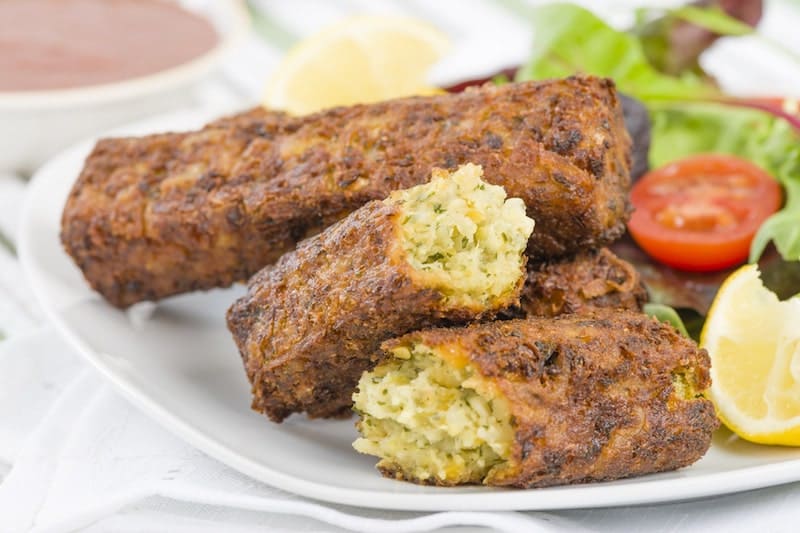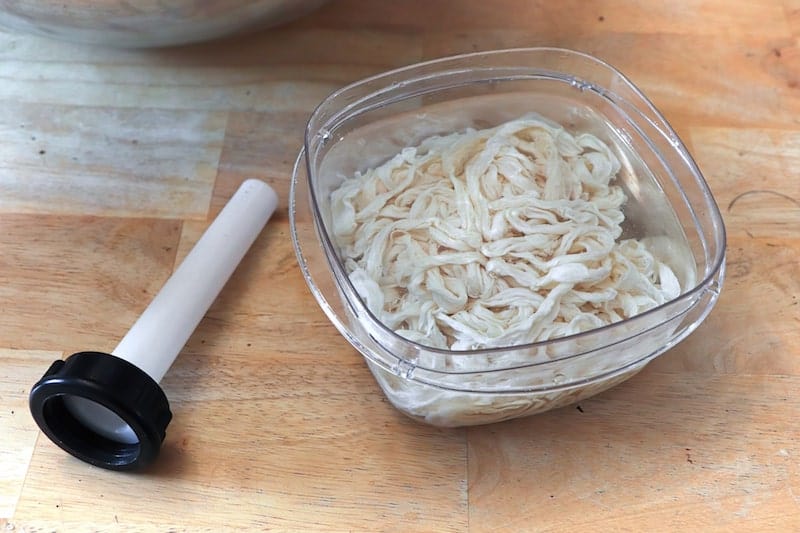Vegetarian Sausage Casing: Everything You Need to Know
If you’re in the sausage-making business, or if you just like to experiment with different vegetarian recipes, you may wonder if a vegetarian sausage casing is available.
Not only can you find vegetarian sausage casing, but vegan sausage casings are available as well. These casings are made from plants and other non-animal-derived ingredients, and they’re much healthier than natural and artificial sausage casings.
In this article, I’ll talk about everything you need to know about vegetarian sausage casing. We’ll cover what they’re made from, how you can store them, and how they’re best used for your sausage recipes.

Can You Get Vegetarian Sausage Casings?
One of the most essential parts of making sausages is getting the right kind of casing. While it’s typically called a sausage ‘casing,’ it’s also known as sausage ‘skin.’
The main types of sausage casing are natural, artificial, and vegetarian.
Natural and Artificial Sausage Casings
Natural sausage casings are made from animal skin or intestines. The most common sausages are made using hog, sheep, cattle, goat, and horse casings.
On the other hand, artificial casings can be made from cellulose, collagen, or plastic. Many natural and artificial casings are edible, the exception being plastic sausage casings.
While typical natural casings vary in length, ranging from two to 14 meters, or 6.6 to 45.9 feet (although beef casings are usually 32 meters or 104.9 feet long), artificial casings are much longer. You can get collagen casings up to 50 meters or 164 feet long.
Vegetarian Sausage Casings
Vegetarian sausage casing is the newest type of sausage skin, and they’re 100% plant-based. They are usually made from water, vegetable glycerin, starches, and sugar.
Not only can you find vegetarian sausage casings, but you can find vegan-friendly sausage casings as well.
Vegetarian sausage casings are also all suitable for both kosher and halal applications. Both types are entirely edible.
Since vegetarian sausage casings aren’t made from animal ingredients, they can also be quite long, usually ranging from 12 to 50 meters (from 39.3 to 164 feet)
How many sausages can you make using a sausage casing of 39.3 feet? You can make around 120 sausages. If you buy a 164-foot vegetarian sausage casing, you can make up to 500 sausages!
As for the width, vegetarian sausage casings come in 23 and 32 millimeters in diameter. So, it may be best to start with the 23-millimeter casings if you’re a beginning sausage maker.
You can try making homemade vegetarian sausage casings, or you can purchase them. However, since they’re relatively new to the sausage-production world, finding them in your local butcher shop might be challenging.
If you’re having trouble buying them locally, you can find vegetarian sausage casings online.
When you order pre-made vegetarian sausage casings, they’re usually ready to be used. However, natural sausage casings or animal casings must be soaked in brine and rinsed with cold water.

While it might be challenging to find vegetarian sausage casings in a supermarket, there are lots of ready-made vegetarian sausages available.
More and more sausage-production companies seem to be making vegetarian sausages, and you can find many of them in local grocery stores and supermarkets.
What Are Vegetarian Sausage Casings Made Of?
Vegetarian sausage casings are made of 100% plant-based ingredients. They’re also hypoallergenic and don’t contain GMOs (genetically modified organisms).
Water-soluble polysaccharide is another common ingredient used to make vegetarian sausage casing. This ingredient is like cellulose, a type of carbohydrate.
Proper Storage of Vegetarian Sausage Casing
Based on their unique ingredients compared to natural or artificial sausage casing, you might be wondering if vegetarian sausage casing can go bad. The answer is yes.
Like animal sausage casings, they can go bad quickly if not stored properly. Knowing how to keep vegetarian sausage casings the right way may be especially important if you have leftover casings and don’t want to throw them away.
Vegetarian sausage casing needs to be stored in a cool, dry area. It can last up to one year if you keep them in a dry sealed container or any other type of vacuum-sealed package.
While you can freeze sausages, it’s not a good idea to freeze sausage casings. The low temperature can damage the casings and significantly change their quality.
How to Use Vegetarian Sausage Casing
Not only can you use vegetarian sausage casing for typical vegetarian sausage, but you can also use it with fish, nuts, and fruit.
In cooking, make sure you don’t soak the casings or expose them to an abundant amount of moisture. This is especially important for when it’s time to stuff them with filling.
There are loads of vegetarian sausage recipes you can use with these sausage casings. However, you’ll need to have a sausage stuffer to make any type of sausage. There’s no limit to what you can think of for your vegetarian sausage recipe.
Alternatives for Vegetarian Sausage Casing
If you can’t find vegetarian sausage casings, there are other alternatives you can try.
For starters, you can use cellulose and plastic sausage casings for your sausages. Cellulose sausage casings are made by processing cotton linters and wood pulp. The final result is viscose, which is a synthetic fiber commonly used in the food industry. These casings are most frequently used with wieners, frankfurters, and other similar types of sausages.
Sausage casings can also be made from plastic. Different polymers are used to create plastic sausage casings, the most common being polyethylene, polyamide, and polypropylene. You should know about plastic sausage casings because they should never be consumed and should be removed before serving.
Cellulose sausage casings can be used for smoking sausages and will retain their shape, but the same is not true with plastic sausage casings. Keep in mind that plastic sausage casings can shrink when you cook your sausages. This happens because the sausages retain the moisture inside.
Finally, if you don’t want to use any of these sausage casings, you can go with the ‘caseless’ option. Some sausage types don’t require a casing to be cooked, while other types easily fall apart without the wrapping.
If you want to make skinless sausages, you should roll them by hand rather than stuffing them in the casings. The best way to make ‘caseless’ sausages is by frying them in a pan.
Also, sausage molds like these can be pretty handy – they’re oven and microwave safe!
Is There a Vegan Sausage Casing?
Vegan sausage casing has become quite popular in recent years and can be bought online. It’s typically made from vegetables and is completely edible.
In addition, most vegan casings on the market don’t contain allergens, gluten, or GMO, for vegans on strict diets.
Vegan sausage casing is usually made from carrageenan, water, glycerin, and starch.
It can be used for various vegetarian and vegan-based recipes that are becoming more prominent in the culinary world. Its high-quality texture makes it feel like you’re eating authentic sausages.
Since vegan sausage casing is edible, you don’t need to remove it once you cook your vegan sausages.
Vegetarian and vegan sausage casings are a much healthier option than natural and artificial sausage casings, which come with plenty of health concerns.
Like vegetarian sausage casings, vegan sausage casings arrive ready-to-use. Since they’re also water-soluble, no soaking, boiling, or rinsing is required before you start cooking them.
They’re best suited for recipes that call for sausages to be baked or grilled. Both vegetarian and vegan sausage casings come supplied on a stick or a rod, making it easier for you to use them.
Sometimes they’re sold rolled up. If you receive the rolled-up variety, you will have to unwind them yourself.
Vegan sausage casings can be cooked in a variety of ways. If you decide to cook or fry them, make sure you’re using low to medium heat. Otherwise, the casings will quickly burst.
You can also prepare them in an air fryer, as long as it’s at 350° Fahrenheit. They can even be smoked.
To make vegan sausages, you can use a combination of beans, oats, and nuts to replace the meat mixture. In addition, there are loads of different ways you can make filling for your vegan sausage casings.
If you can’t find vegan sausage casings, you can perhaps use the ‘caseless’ vegan sausages method.
For example, you can also use plain parchment paper and tin foil instead of sausage casings. This method is generally used for boiling and steaming sausages.
Afterward, you can remove the tin foil and the paper wrapping and fry your vegan sausages without having to worry about them falling apart.
In Summary
Vegetarian sausage casing is a much healthier alternative to natural and artificial sausage casings.
As it’s becoming more and more popular, you’ll be able to find it in larger supermarkets and online shops.
It’s pretty easy to cook with vegetarian and vegan sausage casing, and you can even make your homemade casings. They can be cooked, fried, smoked, and boiled. When it comes to non-meat filling, there are countless recipes you can try.









